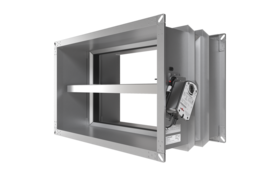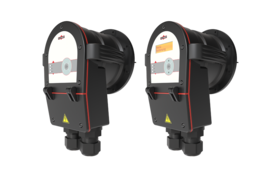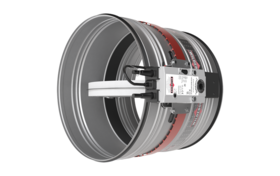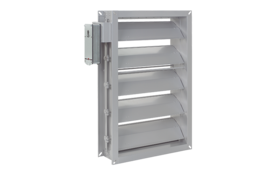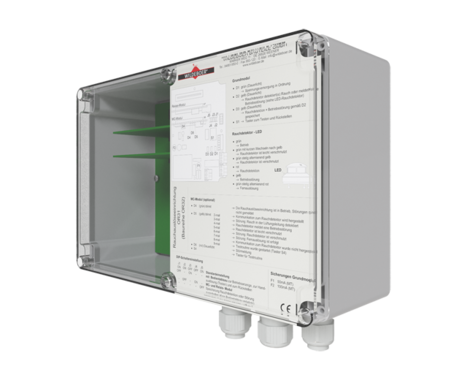
OR32 smoke detector
Technical details
- suitable for square and circular ventilation ducts
- suitable for all fire and smoke protection dampers
- installation in air transfer applications
- approval OR32 Z-78.6-123
- approval Ü-FK Z-6.50-2132
- approval Ü-FR Z-6.50-2133
Product details
OR32 smoke detectors control the internal space of ventilation ducts. In case of smoke a signal occurs that can cause the closing of fire dampers or smoke protection dampers as well as the switching of fans.
The smoke detector can be installed in ventilation ducts, directly in fire dampers or in casing extensions for fire dampers. Thus, fire dampers and smoke detectors can be combined. The electronics of OR32 smoke detector for analysis of the detector and for electrical power connection is located in a control unit with a closed casing made of plastics. The automatic tracking of the response thresholds for smoke detection ensures a long endurance and service life also at contaminations due to operating conditions. Switches for testing of functions and for reset after a smoke detection are located in the control unit.
Operating positions, failures and contamination levels are shown by LEDs, remote indications can be installed.
Technical specifications
| Short item description |
|
| Modules for smoke detector |
|
| Control panel |
|
Media & Downloads
FAQ
The 92 series fire dampers are maintenance-free. Due to their design and the materials used, such as the complete encapsulation of the actuator mechanics, the thermal release device, the motorized actuators, etc., they can do without ongoing maintenance work to maintain their function. Periodic lubrication, for example, is not required. Maintenance is thus limited to functional checks (triggering and reopening of the fire dampers) or repair measures in the event of damage. Hygienic cleaning must be carried out as part of the overall cleaning of the ventilation and air-conditioning system or as required.
Due to the fact that the system is maintenance-free, functional checks may also be carried out remotely. This can be carried out particularly easily and economically via the Wildeboer BS2 communication system for fire dampers with automatic calendar control.
For this purpose, the shut-off damper blade of the fire damper must be closed and opened again. The fire damper can be equipped with different release devices or with electric spring return motors for opening and closing.
For the function test, the manual release must be operated or a remote release must be performed to close the shut-off damper blade of the fire damper. Afterwards, the shut-off damper blade must be opened again.
The respective commissioning and function control measures as well as notes on operation are described in the operating instructions.
You can find our operating instructions in the download area.
When it comes to the functioning and operation of fire dampers in accordance with DIN EN 15650, there are several specifications and obligations that must be complied with. We have summarized the essentials in a document that you can view and download here.
If the fire damper cannot be opened, the fusible link sleeve or the thermoelectric fusible link must be checked for integrity. These must be in proper condition and must not show any damage. Refer to the respective operating instructions for the design and replacement.
In addition, no installed parts may obstruct or block the damper blade freewheeling.
If these measures do not work, please contact our technical support.
You will find our operating instructions in the download area.
A minimum distance to adjacent walls and ceilings is not required when installing square fire dampers from Wildeboer Bauteile GmbH. Only a small distance is required for the round fire damper FR90.
The corresponding specifications can be found in the respective user manuals.
We have summarized details on the handling of fire dampers with asbestos-containing building materials for you in this document (german).
No. The fire dampers each have two inspection openings. These allow a view into the interior of the fire damper, on both sides of the damper blade. Inspection openings can be ordered as an option for the FK90 fire damper. These do not replace openings of corresponding size, which must be provided for cleaning purposes based on relevant standards and guidelines.
Yes, the AMP connectors can be removed.
Yes. The fire dampers are equipped with an electric spring return motor or a thermal-mechanical release device (TMA) at the factory. A fire damper equipped with a TMA at the factory can be retrofitted with a spring return motor. Complete actuator units for the particular damper type are required for the retrofit. These include the motor console, the spring return motor and the electric fusible link.
Yes, it is possible to retrofit a limit position switch for both the open and closed positions of the fire damper. Spring return motors have both limit switches as standard.
An elastic connector, also called an expansion compensator or canvas connector, is suitable for installation between a ventilation duct and components of a ventilation system, e.g. a fire damper. It can absorb changes in the length of the connected duct, burn off in the event of a fire and thus prevent the transmission of force from the ventilation duct to the fire damper.
FK90, FR90 (FR92 and FR92K series) and FK90K fire dampers are CE marked construction products according to the harmonized product standard DIN EN 15650. They can be connected on one or both sides to ventilation ducts made of non-combustible or combustible building materials. In the event of fire, thermal expansion of these ducts must not exert any significant forces on the fire damper. Compensatory measures must be provided in accordance with local requirements. In Germany, the "Guideline on Fire Protection Requirements for Ventilation Systems", or "Ventilation System Guideline - LüAR" for short, contains building code requirements for implementation and necessity. In general, compensation is achieved by suitable pipe routing. There is no general requirement for the use of flexible connectors.
In addition, when using the FK90 fire damper for commercial kitchens, the specifications of the general building inspection approval Z41.3-670 must be observed. Ventilation ducts made of galvanized or stainless steel must be connected. For the installation of the ventilation duct and limitation of forces, the above-mentioned guideline must also be referred to.
In addition, ventilation ducts on FK90 fire dampers for commercial kitchens are in accordance with the building authority approval
- in metal stud walls
- in walls made of gypsum wallboards
via suitable elastic connectors (expansion compensators) made of combustible building materials, at least building material class B2 according to DIN 4102-1. An expansion allowance of ≥ 100 mm in the installed state is required.
On 01 July 2013, the European Construction Products Regulation (CPD, No. 305/2011) came into full force in all EU member states after a transitional period and replaced the Construction Products Directive (CPD, No. 89/106/EEC).
Newly produced fire dampers that fall under the harmonized product standard EN 15650 must already be marked with the CE conformity mark since 01 September 2012. Since July 01, 2013, the manufacturer has also been required to submit a declaration of performance (DoP). He thus assumes responsibility for the conformity of the fire damper with the declared performance. The declarations of performance are available for:
As a result, Deutsches Institut für Bautechnik (DIBt) may no longer issue or extend general building inspectorate approvals (abZ) for fire dampers that fall under the harmonized product standard EN 15650 and must therefore bear a CE marking. They may no longer be required as proof of usability for national construction projects.
The information required for installation and assembly is fully described in the comprehensive user manuals.









